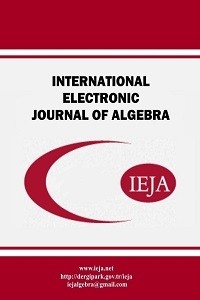A REIDEMEISTER-SCHREIER THEOREM FOR FINITELY L-PRESENTED GROUPS
We prove a variant of the well-known Reidemeister-Schreier Theorem for finitely L-presented groups. More precisely, we prove that each finite index subgroup of a finitely L-presented group is itself finitely L-presented. Our proof is constructive and it yields a finite L-presentation for the subgroup. We further study conditions on a finite index subgroup of an invariantly finitely L-presented group to be invariantly L-presented itself.
Keywords:
Reidemeister-Schreier Theorem, infinite presentations, recursive presentations, self-similar groups, Basilica group, Grigorchuk group finite index subgroups,
___
- L. Bartholdi, Endomorphic presentations of branch groups, J. Algebra, 268(2) (2003), 419–443.
- L. Bartholdi, B. Eick, and R. Hartung, A nilpotent quotient algorithm for certain infinitely presented groups and its applications, Internat. J. Algebra Comput., 18(8) (2008), 1321–1344.
- L. Bartholdi and R. I. Grigorchuk, On parabolic subgroups and Hecke algebras of some fractal groups, Serdica Math. J., 28(1) (2002), 47–90.
- L. Bartholdi and O. Siegenthaler, The twisted twin of the Grigorchuk group, Internat. J. Algebra Comput., 24(4) (2010), 465–488.
- L. Bartholdi and B. Vir´ag, Amenability via random walks, Duke Math. J., 130(1) (2005), 39–56.
- G. Baumslag, A finitely generated, infinitely related group with trivial multi- plicator, Bull. Austral. Math. Soc., 5 (1971), 131–136.
- W. W. Boone, The word problem, Ann. of Math. (2), 70 (1959), 207–265.
- C. M. Campbell, E. F. Robertson, N. Ruˇskuc, and R. M. Thomas, Reidemeister-Schreier type rewriting for semigroups, Semigroup Forum, 51(1) (1995), 47–62.
- J. J. Cannon, L. A. Dimino, G. Havas, and J. M. Watson, Implementation and analysis of the Todd-Coxeter algorithm, Math. Comp., 27 (1973), 463–490.
- R. Grigorchuk, Solved and unsolved problems around one group, In InŞnite groups: geometric, combinatorial and dynamical aspects, volume 248 of Progr. Math., pages 117–218. Birkh¨auser, Basel, 2005.
- R. I. Grigorchuk, On Burnside’s problem on periodic groups, Funktsional. Anal. i Prilozhen., 14(1) (1980), 53–54.
- R. I. Grigorchuk, On the system of defining relations and the Schur multiplier of periodic groups generated by finite automata In Groups St. Andrews 1997 in Bath, I, volume 260 of London Math. Soc. Lecture Note Ser., pages 290–317. Cambridge Univ. Press, Cambridge, 1999.
- R. I. Grigorchuk and A. ˙Zuk, On a torsion-free weakly branch group defined by a three state automaton, Internat. J. Algebra Comput., 12(1-2) (2002), 223– 246. International Conference on Geometric and Combinatorial Methods in Group Theory and Semigroup Theory (Lincoln, NE, 2000).
- R. Hartung, A nilpotent quotient algorithm for finitely L-presented groups, Diploma thesis, Technische Universit¨at Braunschweig, 2008.
- R. Hartung, Approximating the Schur multiplier of certain infinitely presented groups via nilpotent quotients, LMS J. Comput. Math., 13 (2010), 260–271.
- R. Hartung, Coset enumeration for certain infinitely presented groups, Inter- nat. J. Algebra Comput., 21(5) (2011).
- G. Havas, A Reidemeister-Schreier program, In Proceedings of the Second International Conference on the Theory of Groups (Australian Nat. Univ., Canberra, 1973), pages 347–356. Lecture Notes in Math., Vol. 372, Berlin, 1974. Springer.
- G. Havas and E. F. Robertson, Application of computational tools for finitely presented groups, In Computational support for discrete mathematics (Piscat- away, NJ, 1992), volume 15 of DIMACS Ser. Discrete Math. Theoret. Comput. Sci., pages 29–39. Amer. Math. Soc., Providence, RI, 1994.
- I. Kapovich and D. T. Wise, On the failure of the co-Hopf property for sub- groups of word-hyperbolic groups, Israel J. Math., 122 (2001), 125–147.
- W. Krull, ¨Uber verallgemeinerte endliche Abelsche Gruppen. M. Z., 23 (1925), 161–196.
- J. Leech, Coset enumeration on digital computers. Proc. Camb. Philos. Soc., 59 (1963), 257–267.
- E. H. Lo, A polycyclic quotient algorithm, J. Symbolic Comput., 25(1) (1998), 61–97.
- R. C. Lyndon and P. E. Schupp, Combinatorial group theory, Springer-Verlag, Berlin, 1977. Ergebnisse der Mathematik und ihrer Grenzgebiete, Band 89.
- I. G. Lys¨enok, A set of defining relations for the Grigorchuk group, Mat. Za- metki, 38(4) (1985), 503–516.
- J. Neub¨user, An elementary introduction to coset table methods in computa- tional group theory, In Groups—St. Andrews 1981 (St. Andrews, 1981), vol- ume 71 of London Math. Soc. Lecture Note Ser., pages 1–45. Cambridge Univ. Press, Cambridge, 1982.
- B. Neumann, Some remarks on infinite groups, J. Lond. Math. Soc., 12 (1937), 120–127.
- W. Nickel, Computing nilpotent quotients of finitely presented groups, In Geo- metric and computational perspectives on inŞnite groups (Minneapolis, MN and New Brunswick, NJ, 1994), volume 25 of DIMACS Ser. Discrete Math. Theoret. Comput. Sci., pages 175–191. Amer. Math. Soc., Providence, RI, 1996.
- E. Noether, Hyperkomplexe Gr¨oßen und Darstellungstheorie, M. Z., 30 (1929), 641–692.
- P. S. Novikov, Ob algoritmiˇcesko˘ı nerazreˇsimosti problemy toˇzdestva slov v teorii grupp, Trudy Mat. Inst. im. Steklov. no. 44. Izdat. Akad. Nauk SSSR, Moscow, 1955.
- K. Reidemeister, Knoten und Gruppen, Abhandlungen Hamburg, 5 (1926), 7–23.
- O. Schreier, Die Untergruppen der freien Gruppen, Abhandlungen Hamburg, 5 (1927), 161–183.
- C. C. Sims, Computation with Şnitely presented groups, volume 48 of En- cyclopedia of Mathematics and its Applications, Cambridge University Press, Cambridge, 1994.
- J. Todd and H. Coxeter, A practical method for enumerating cosets of a finite abstract group, Proceedings of the Edinburgh Mathematical Society (Series 2), 5(1) (1936), 26–34. Ren´e Hartung
- Mathematisches Institut
- Georg-August Universit¨at zu G¨ottingen Bunsenstraße 3–5
- G¨ottingen, Germany
- e-mail: rhartung@uni-math.gwdg.de
- ISSN: 1306-6048
- Yayın Aralığı: Yılda 2 Sayı
- Başlangıç: 2007
- Yayıncı: Abdullah HARMANCI
